Laksmivan Prabhu:
Srila Prabhupada didn’t like us singing songs without knowing their meaning.
The spiritual master is never touched by the three modes of material nature.
In the brief time Srila Prabhupada was present, his encouragement and the youthfulness of his followers combined to spread make Krishna consciousness dramatically.
Everyone was aware anyone could please him by distributing his books.
Even now, by distributing books and doing harinama, we can feel Prabhupada’s presence.
Palaka Prabhu:
Srila Prabhupada explains the situation of the pure devotee, and thus his own situation, in his purport to Srimad-Bhagavatam 1.13.55:
“A pure devotee of the Lord does not live on any planet of the material sky, nor does he feel any contact with material elements. His so-called material body does not exist, being surcharged with the spiritual current of the Lord’s identical interest, and thus he is permanently freed from all contaminations of the sum total of the mahat-tattva. He is always in the spiritual sky, which he attains by being transcendental to the sevenfold material coverings by the effect of his devotional service. The conditioned souls are within the coverings, whereas the liberated soul is far beyond the cover.”
Do not let Prabhupada disappear from your life. Keep him present by hearing from him.
Kalindi Devi Dasi:
Although living in Vrindavan, I was visiting Delhi the day Srila Prabhupada left this world, and I returned in the evening. I recall one godbrother, insufficiently dressed for the cold November evening, chanted bhajans all night before Srila Prabhupada’s body, before it was interred.
Dinanatha Prabhu:
Prabhupada said even if you do not understand, continue hearing and someday you will understand.
We would hear him speak in Hindi and would somehow understand.
The ear processes information 1000 times faster than the eye.
The devotees loved to please Srila Prabhupada, and he loved to please them.
He stressed “you are not the body” and “life is meant for self-realization.”
Sugata Prabhu:
When I first saw Srila Prabhupada step out of a car in Vrindavan in 1974, I realized he really was a pure devotee and I also realized, in shock, that I would have to surrender to him. I am still trying to do that.
To see the photos I did not include in this blog, click on the link below:
Insights
Bhaktimarga Swami:
From a talk on walking at the Bhakti Center:
Walking is a chance to make friends. It is a friend raiser rather than a fund raiser.
I find the media is favorable and willing to learn.
Walking helps you focus on the present.
Devotional clothes make a difference. I have been called Buddha, Jesus, and Gandhi.
Walking is a chance for communication. It gives people a chance to perform service to the sankirtana movement. It shows people we are there. It can make you more sensitive.
We get into elementary schools and yoga centers.
When walking, you cannot help but wonder what it was like before the Europeans came to the West.
We have had incredible Hindu hosts, though usually we camp and bath in rivers and camp sites.
People from the Film Board of Canada traveled with me for a month, and we are part of their documentary, The Longest Road.
Srila Prabhupada said the GBCs (Governing Board Commissioners) should travel with brahmacaris throughout their zones.
I started walking in 1996 as an offering to Srila Prabhupada for the centennial of his birth.
My mantra for new devotees is “you are taking over.”
Every time you do a long walk, it gets better and better.
Now there is more security than when I started in 1996, but there is also more acceptance by the people I meet.
I told Ambarish (Alfred Ford) that I do not like cars. I do not like what they have done to the world. Ambarish said, “I don’t like cars either.”
In 2016 I plan to walk from New York City to San Francisco to encourage Americans in a more car-free, care-free life.
The food we eat is garbage. The wild food is heavenly.
We found a deity of Ganesh in a lake we went swimming in.
I would be happy if I could walk until I am 108.
Many people who do long distance walking end up believing in God after.
Jayadvaita Swami:
From a lecture on Govardhan Puja on this verse spoken by the gopis (Srimad-Bhagavatam 10.21.18): “Of all the devotees, this Govardhana Hill is the best! O my friends, this hill supplies Krishna and Balarama, along with Their calves, cows and cowherd friends, with all kinds of necessities — water for drinking, very soft grass, caves, fruits, flowers and vegetables. In this way the hill offers respects to the Lord. Being touched by the lotus feet of Krishna and Balarama, Govardhana Hill appears very jubilant.”
The gopis praise Govardhana Hill for the variety of services it renders to Krishna, while they feel they themselves are unable to do so much. This is the attitude of the advanced devotee.
Annakuta comes from two words, anna meaning rice, more generally grains, or even food, and kuta which means mountain.
Everyone was pleased by Govardhan Puja except Indra.
As you [the New York Harinam devotees] seek shelter in the subway station from the rain, the residents of Vrindavan sought shelter from the rains sent by Indra. They did not have subways, so Krishna lifted up Govardhan Hill to protect them.
Govardhan Puja has all the elements to attract people all over the world, just as does the Jagannath Ratha-yatra. I envision someday a massive Govardhan Puja festival in Madison Square Garden.
Q: What is your favorite sweet?
A: Pure devotional service. The only problem is I cannot get enough of it. In Nectar of Devotion it is said that it is rarely attained.
Keshava Bharati Maharaja renovated a broken down old palace to create our present Govardhana facility. Vasesika Prabhu and others take shelter of our Govardhana ashram and read Srila Prabhupada’s books there hours a day during Karttika (October-November).
Rupa Goswami exalts Govardhana above Vaikuntha [the kingdom of God] and even Vrindavan [Lord Krishna’s personal abode].
Sridhara Maharaja said that Bhaktisiddhanta Saravati Thakura did not stay at Radha Kund. He considered Radha Kund the place of residence of his superiors.
Srila Prabhupada wanted us to strictly follow so we could ultimately attain the highest state.
We are dancing into the pastimes of Radha and Krishna by our sankirtana and our preaching, not being babajis or dressing in saris in Radha Kund.
Srila Prabhupada said the entire spiritual world is contained within the four walls of our Krishna Balaram temple compound in Vrindavan.
Comment by Abhiram Prabhu: When the sun shines from different angles at Govardhana, the rocks reflect different colors.
If you do not observe Govardhana Puja you will be bitten by snakes of Govardhana Hill.
Comment by Rama Raya Prabhu: Or the snakes of material desire.
Romapada Swami:
The Lord, having just encountered the brahmanas performing sacrifices in the forest, returned to Vrindavan to find its residents performing a similar sacrifice.
The Govardhan pastime is meant to teach us that there is one Supreme Lord, who is the recipient of all sacrifices, and that is Krishna, and also that Krishna and Govardhan are nondifferent.
Children who hear Krishna book when they go to sleep when they are young become so attached to it they will not go to sleep without hearing it, even though they can explain it themselves.
George Harrison donated $19,000 for the printing of the Krishna book. Srila Prabhupada never forgot George, and a few months before Srila Prabhupada left this world, he gave Tamal Krishna Goswami his sapphire ring to give to George as a gift.
Palaka Prabhu:
From a conversation over prasadam:
Kalindi Devi Dasi, former wife of Rupanuga Prabhu, says that in the sixties, she asked Rupanuga before he had met the devotees, where he wanted her to take him for his birthday. He had just seen in the local newspaper the picture of Srila Prabhupada singing with his disciples in Tompkins Square Park, so he told her he wanted to go to the park and chant with the Swami. So they did. She took care of their kid, and he listened to Prabhupada sing.
Sikhi Mahiti Prabhu (Philadelphia temple president):
The Padma Purana states that chanting Rama once has the same potency as chanting Narayana one thousand times, and chanting Krishna once has the same potency as chanting Rama three times.
The holy name is so powerful people do not have to agree with it, they just have to hear it.
Anyone who hears the devotees chanting Hare Krishna is a mahatma, a great soul. It is so rare.
In the initiation letters throughout the 1970s, Srila Prabhupada would regularly list street sankirtana [congregational chanting of the holy name] as a duty of the newly initiated disciple.
Comment by Vishnu Gada Prabhu:
In New York City, when Srila Prabhupada visited in 1971 or 1972, he spoke on the first three chapters of Canto 6 of Srimad-Bhagavatam. He said that Maharaja Pariksit inquired about how the living entities could be delivered from the hells described at the end of Canto 5 because that is the kind nature of the devotee of the Lord. He quoted the verse “kecit kevalaya bhaktya / vasudeva-parayanah / agham dhunvanti kartsnyena / niharam iva bhaskarah: Only a rare person who has adopted complete, unalloyed devotional service to Krishna can uproot the weeds of sinful actions with no possibility that they will revive. He can do this simply by discharging devotional service, just as the sun can immediately dissipate fog by its rays.” (Srimad-Bhagavatam 6.1.15) He said the Ajamila story is an explanation of this verse. The Hare Krishna mantra is an explanation of this verse: “aho bata sva-paco ’to gariyan / yaj-jihvagre vartate nama tubhyam / tepus tapas te juhuvu? sasnur arya / brahmanucur nama grinanti ye te: Oh, how glorious are they whose tongues are chanting Your holy name! Even if born in the families of dog-eaters, such persons are worshipable. Persons who chant the holy name of Your Lordship must have executed all kinds of austerities and fire sacrifices and achieved all the good manners of the Aryans. To be chanting the holy name of Your Lordship, they must have bathed at holy places of pilgrimage, studied the Vedas and fulfilled everything required.” (Srimad-Bhagavatam 3.33.7)
An Indian devotee, who gives classes in Potomac on Sunday mornings:
Underneath Govardhana Hill, although you would expect to find a lot of dirt, there were grass and streams. Stones fell from the Hill and surrounded the perimeter thus keeping the water out. The light of Krishna’s toe nails illuminated everything.
Indra, the boys, and Yasoda were in anxiety. Indra was in anxiety because he offended Krishna, the boys were scared that Krishna’s flute playing would melt the stones of Govardhana Hill, and Yasoda was worried that Krishna was hungry. Krishna reassured the boys.
Krishna will deliver us if we take shelter of Him as did the residents of Vrindavan.
Indra’s mother advised him to approach his guru, Brhaspati, who advised him to approach Brahma, who told him to surrender to Krishna. This shows the value of devotee association.
Krishna corrected Indra in a secluded place, demonstrating his ideal leadership.
Engaging everything we have in devotional service to Krishna will protect us.
—–
kuveratmajau baddha-murtyaiva yadvat
tvaya mocitau bhakti-bhajau krtau ca
tatha prema-bhaktim svakam me prayaccha
na mokse graho me ’sti damodareha
“O Lord Damodara, just as the two sons of Kuvera–Manigriva and Nalakuvara–were delivered from the curse of Narada and made into great devotees by You in Your form as a baby tied with rope to a wooden grinding mortar, in the same way, please give to me Your own prema-bhakti [pure loving devotion]. I only long for this and have no desire for any kind of liberation.” (“Damodarastakam”, verse 7)



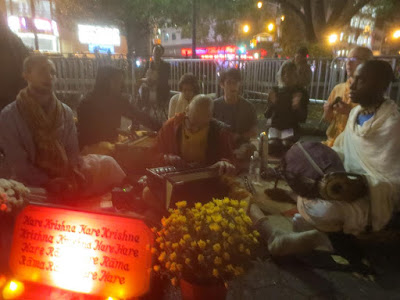

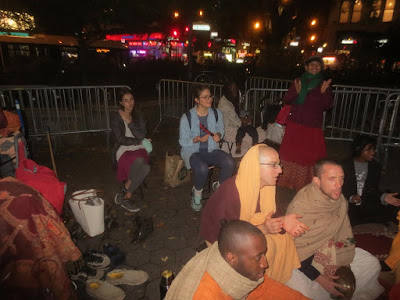


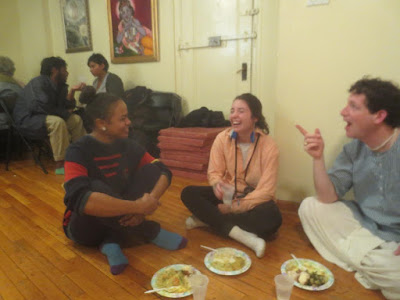



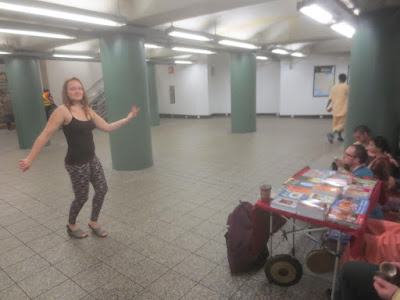







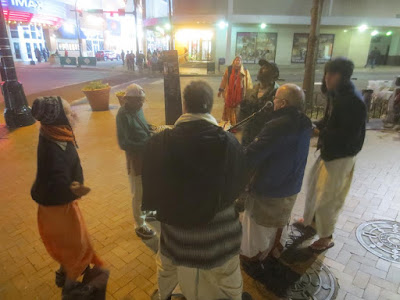








 By Giriraj Swami
By Giriraj Swami